Cleaning IBIS/ISGRI sky images
|
| ESA's INTErnational Gamma-Ray Astrophysics Laboratory (INTEGRAL) has accumulated a lot of exposure time in the direction of the Galactic Plane (GP) with a maximum of 20 Ms of nominal time in the direction of the Galactic Center (GC). However, the growing exposure time devoted to the Plane and the Center of the Galaxy is not reflected by a corresponding increase in survey sensitivity. Observations in these regions are strongly affected by the systematics related to the crowded field of the Galactic Center. |
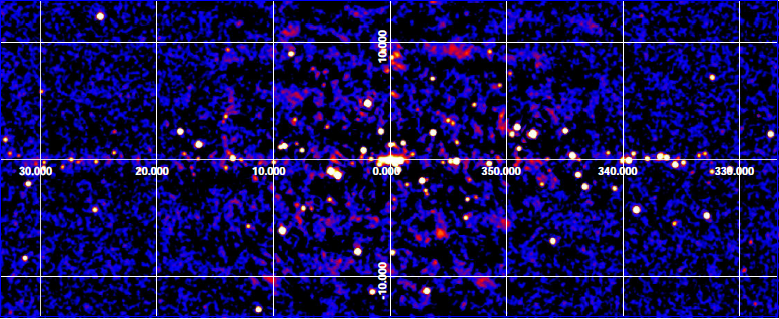 |
| Figure: Map of the sky region near the Galactic plane obtained with IBIS/ISGRI coded aperture telescope in the hard X-ray energy band 17-60 keV. The total exposure is about 20 Ms in the region of the Galactic Center (central region of the map). |
| The image above demonstrates reconstructed sky of the central part of the Galaxy. The bright spots are galactic compact sources of X-ray radiation like accreting black holes and neutron stars (see Wiki pages on X-ray binaries) and background AGNs. The angular size of point sources on this map is limited by 12 arcmin spatial resolution of the IBIS telescope. The underlying sky background is not flat as it should be for coded-aperture imaging. Strong systematic artifacts mimic extended structures on the sky. |
General sky reconstruction
|
| IBIS is a coded aperture imaging telescope. The sky is projected on to the detector plane through the transparent and opaque elements of the mask mounted above the detector plane. Generally, the sky reconstruction is based on the deconvolution of the detector image with a known mask pattern. IBIS mask has replicated patterns which cause appearence of false sources ("ghosts") at certain sky positions. To overcome misleading detections, the ghosts of known bright sources have to be removed. |
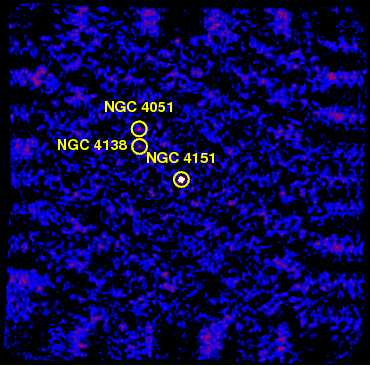 After removing the source "ghosts" we see the systematic effects on sky images. These residuals can be clearly seen on deep extragalactic observations in so called staring mode. In these observations orientation and the roll angle of the telescope are fixed. The sky images are stacked (pixel-to-pixel) in detector coordinates. All systematic residuals, not visible on images of individual observations are amplified on the stacked image. The sky region around NGC 4151, was reconstructed with the help of the general deconvolution algorithm from the data collected in the staring mode (image to the right). The characteristic chessboard-like squares and ripples are clearly seen in the field of view. After removing the source "ghosts" we see the systematic effects on sky images. These residuals can be clearly seen on deep extragalactic observations in so called staring mode. In these observations orientation and the roll angle of the telescope are fixed. The sky images are stacked (pixel-to-pixel) in detector coordinates. All systematic residuals, not visible on images of individual observations are amplified on the stacked image. The sky region around NGC 4151, was reconstructed with the help of the general deconvolution algorithm from the data collected in the staring mode (image to the right). The characteristic chessboard-like squares and ripples are clearly seen in the field of view.
As the spatial scale of systematic artifacts on the sky is significantly different from that of the point sources, we can implement the wavelet-based image filtering procedure. The key point of all wavelet methods is that the wavelet transform (WT) is able to distinguish structures as a function of the spatial scale.
In the context of an individual IBIS/ISGRI observation, we are interested in removing all large-scale structures from non-uniform sky background. The task is greatly simplified by the fact, that the coded-mask aperture technique is not able to reconstruct an image of objects with a spatial size greater than the angular resolution of the telescope. For point source detection all structures more extended than a point source can be safely removed. In other words, we do not need any thresholds to
distinguish noise and signal, we can remove systematic residuals with a given angular scale "as is". In this way, the WT works as a non-parametric sky background approximation. |
Sky image cleaning with Wavelet decomposition
|
To decompose a sky image, we use the so called "a trous" digital wavelet transform (DWT) algorithm. The method uses a kernel KJ=FJ-FJ+1, where integer J is the so called spatial scale index. Each FJ is constructed by five weighting coefficients [1,4,6,4,1]/16 spaced by a 2**(J-1) interval. The convolution of an image with FJ preserves flux (Σ FJ=1), and convolution with KJ emphasizes the structures with the characteristic size 2**(J-1) pixels, or 2**(J+1) arcminutes in the case of the IBIS/ISGRI image (1 pix = 4 arcmin). Thus, low J values correspond to small spatial variations or high frequency, and high J reflects large spatial variations or low frequency.
On the largest scale N the kernel KN=FN. The original image I can be easily decomposed to its convolutions, WJ ("wavelet planes of scale J"), with kernels KJ: I=Σ WJ. The sky region around NGC 4151 can be represented by the sum of the following wavelet planes:
|
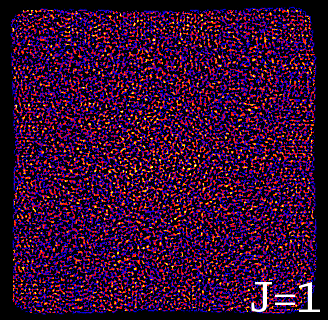
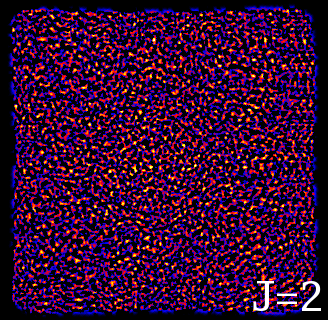
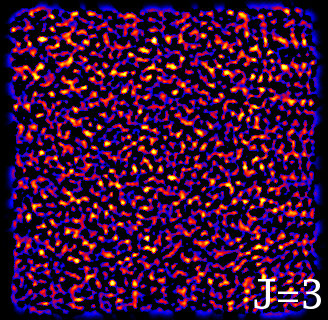
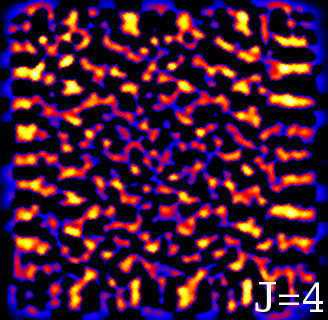




|
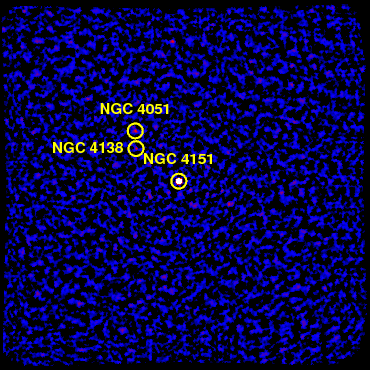 To remove the large-scale systematic structures visible in the region around NGC 4151 we sum up wavelet scales omitting indexes J=5,6,7 where systematic residuals are clearly seen. The scale J=4 can be also rejected, but we leave it to avoid possible suppression of the point source signal at high spatial frequencies. We performed DWT cleaning procedure for each observation of the NGC 4151 observational campaign, and made the mosaic image shown on the right. It is clearly seen that all large-scale artifacts were totally removed, leaving a clean sky image.
To remove the large-scale systematic structures visible in the region around NGC 4151 we sum up wavelet scales omitting indexes J=5,6,7 where systematic residuals are clearly seen. The scale J=4 can be also rejected, but we leave it to avoid possible suppression of the point source signal at high spatial frequencies. We performed DWT cleaning procedure for each observation of the NGC 4151 observational campaign, and made the mosaic image shown on the right. It is clearly seen that all large-scale artifacts were totally removed, leaving a clean sky image. |
| We are mainly interested in improving sensitivity in the region of the Galactic Plane where most of the exposures were collected. Processing each individual observation with wavelets (and improving detector background model, see full paper) we obtain a new deep image of the GP which is demonstrated below. As seen from the sky image, most of the systematic artifacts are removed, leaving a more or less uniform sky background. Obviously, the quality of the reconstructed sky is improved. |
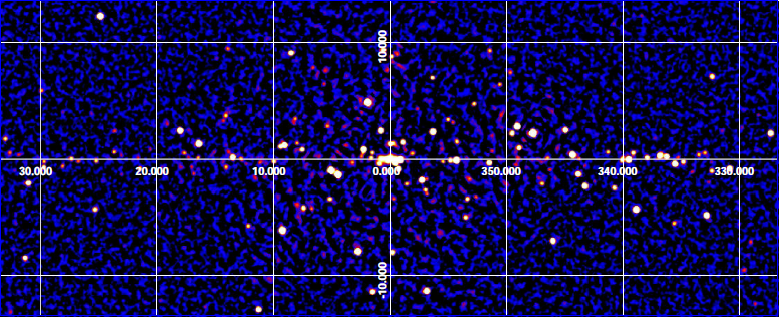 |

 After removing the source "ghosts" we see the systematic effects on sky images. These residuals can be clearly seen on deep extragalactic observations in so called staring mode. In these observations orientation and the roll angle of the telescope are fixed. The sky images are stacked (pixel-to-pixel) in detector coordinates. All systematic residuals, not visible on images of individual observations are amplified on the stacked image. The sky region around NGC 4151, was reconstructed with the help of the general deconvolution algorithm from the data collected in the staring mode (image to the right). The characteristic chessboard-like squares and ripples are clearly seen in the field of view.
After removing the source "ghosts" we see the systematic effects on sky images. These residuals can be clearly seen on deep extragalactic observations in so called staring mode. In these observations orientation and the roll angle of the telescope are fixed. The sky images are stacked (pixel-to-pixel) in detector coordinates. All systematic residuals, not visible on images of individual observations are amplified on the stacked image. The sky region around NGC 4151, was reconstructed with the help of the general deconvolution algorithm from the data collected in the staring mode (image to the right). The characteristic chessboard-like squares and ripples are clearly seen in the field of view.







 To remove the large-scale systematic structures visible in the region around NGC 4151 we sum up wavelet scales omitting indexes J=5,6,7 where systematic residuals are clearly seen. The scale J=4 can be also rejected, but we leave it to avoid possible suppression of the point source signal at high spatial frequencies. We performed DWT cleaning procedure for each observation of the NGC 4151 observational campaign, and made the mosaic image shown on the right. It is clearly seen that all large-scale artifacts were totally removed, leaving a clean sky image.
To remove the large-scale systematic structures visible in the region around NGC 4151 we sum up wavelet scales omitting indexes J=5,6,7 where systematic residuals are clearly seen. The scale J=4 can be also rejected, but we leave it to avoid possible suppression of the point source signal at high spatial frequencies. We performed DWT cleaning procedure for each observation of the NGC 4151 observational campaign, and made the mosaic image shown on the right. It is clearly seen that all large-scale artifacts were totally removed, leaving a clean sky image.